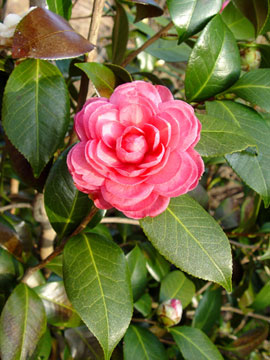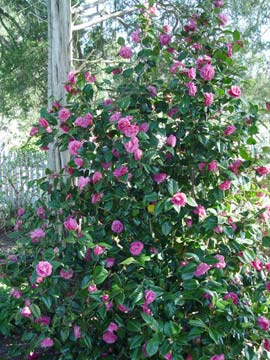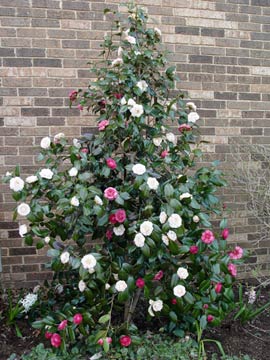The camellia has long been a staple of Southeastern and other mild-winter landscapes with its glossy, evergreen foliage and rose-like flowers. Thanks to recent breeding and warmer winters, a surprising number of camellias now are good options in colder American gardens – or at least those where winter lows usually don’t go much below 0 degrees. So-called “hardy camellias” give Northern and Midwestern gardeners a new alternative to azaleas, rhododendrons, mountain laurels and Japanese andromeda.
 Camellia flowers resemble a rose and produce some of the showiest flowers of any shrub.
Camellia flowers resemble a rose and produce some of the showiest flowers of any shrub.
© George Weigel
As with those broad-leaf evergreens, camellias prefer the same shaded, protected and acid-soil planting conditions. Growing camellias in the North vs. the South involve some important differences.
For starters, variety is important. Not just any camellia can survive winters where it’s common for overnight temperatures to dip into the single digits. Some camellia varieties have been bred and selected for superior cold-hardiness. These are generally the species Camellia oleifera, Camellia japonica, Camellia sasanqua and especially hybrids of those.
You’ll find cold-hardy camellias that bloom either in late fall or very early spring. That’s a key attraction of camellias in addition to their evergreen foliage and striking flowers… they bloom at a time of year when little else is in color. Fall-blooming hardy camellias are available under such series names as ‘Winter’ and ‘Ashton.’ Early spring bloomers are available under such series names as ‘Spring’ and ‘April.’

Camellias have long been popular in warm climates, but cold-hardy types are now available where winter lows reach 0 degrees.
© George Weigel
One of the best ways to tell if a camellia is winter-hardy in your area is whether local nurseries are selling it. Retailers usually stick with varieties known to be hardy in their particular climates. That doesn’t mean a camellia is doomed if you buy one on the way back from a trip to the South. It just means the survival odds are less.
Another option is to check a variety’s winter-hardiness label. Look for varieties that are cold-hardy down to USDA Hardiness Zone 6B – meaning winter lows that bottom out at 0 to minus 5 degrees. Even cold-hardy camellias are iffy in winters much colder than that. But even in Zones 6A or lower, careful siting and a few warm winters in the early years may make camellias possible.
In cold climates, when and where you plant a camellia is more critical than in warmer climates. North and northwest exposures are ideal camellia spots in cooler climates – and in particular, sites that are protected from winds by walls, buildings or a windbreak of tall evergreens. Camellias appreciate this winter shading and protection because it gives them more consistent winter dormancy and prevents cold winter winds from drying their large leaves when the ground is frozen and unable to resupply the roots with moisture.
 It’s especially important to plant cold-climate camellias in a wind-protected area, such as along a wall.
It’s especially important to plant cold-climate camellias in a wind-protected area, such as along a wall.
© George Weigel
Research has found that camellias are more susceptible to winter injury when the plants break dormancy due to fluctuating winter temperatures. That can happen not only in open, southern exposures but in eastern exposures when the morning sun suddenly warms a camellia after a cold night.
Camellias also tolerate winter weather better when planted higher on a slope and not in a low-lying “frost pocket” where cold air settles in winter. Spring planting (April and May) is by far better than fall planting in the North. Reason: it gives the young roots more time to establish before the stress of a first winter. Also helpful is wrapping a new camellia in burlap the first winter or two. Pound stakes around the plant and make a cylinder of burlap around it as opposed to letting the fabric touch the plant.
Camellias prefer loose, well drained soil, so work an inch or two of compost, rotted leaves, peat moss or similar organic matter into the existing soil at planting time. All camellias do best in acidy soil as well, so check the pH and add sulfur if the reading isn’t 6 or lower.
Use a fertilizer specially formulated for camellias. For the first three years, scratch fertilizer into the surrounding soil three times a year – early spring, late spring and mid to late fall. Then cut back to twice a year – early spring and mid to late fall.
If you’re still infatuated with this Asian-native shrub but live in cold areas that are even beyond the range of cold-hardy camellias, try growing in containers. Camellias do well in containers set outside on decks or patios in summer and then moved into an unheated, bright spot in winter, such as a sun porch or garage with a window.
Fertilize container camellias every 4 to 6 weeks with GreenView with GreenSmart Azalea, Camellia and Rhododendron Food, and keep the soil consistently damp, including with occasional light waterings during winter storage. If the unthinkable happens and you find your camellia leafless at winter’s end, don’t give up too soon.
Winter-injured camellias often are still alive at the root level and will push out new growth – sometimes as late as June.